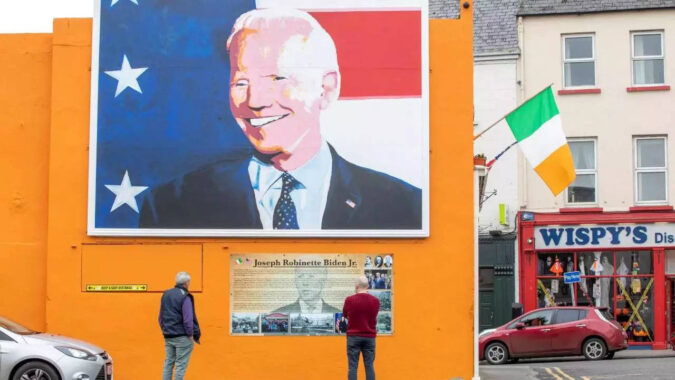BALLINA: US President Joe Biden on Friday was set to wrap up his nostalgic three-day tour to Ireland, the longest ever by a US leader, with a rally in the West of Ireland hometown of his great-great-great-grandfather.
The tour, a celebration of his close links to his ancestral homeland and deep Catholic faith, has provided a preview of his planned 2024 re-election campaign, with enthusiastic flag-waving crowds, photo-ops with babies and long, loquacious speeches.
“He draws energy from politics, he draws energy from people. He’s a natural politician,” said Irish Foreign Minister Micheal Martin, who spent Wednesday afternoon with Biden greeting crowds in County Louth in the northeast.
“There’s no waning of the appetite is what I would have detected in those last few days,” Martin told state broadcaster RTE.
Biden started his tour on Wednesday in Belfast on a more serious note by urging political leaders there to restore their powersharing government. On Thursday, he became the fourth US president to address the Irish parliament and attended a state banquet at Dublin Castle.
After leaving Dublin, Biden was due to visit the Catholic shrine at Knock, in northwestern Ireland, where he will be presented with a stone from the gable wall of the Church where the Virgin Mary is said to have appeared in 1879.
He will later travel to Ballina, the hometown of Biden’s great-great-great-grandfather Edward Blewitt, who emigrated to the United States with his wife and their eight children in 1851.
Biden will address a crowd in front of St Muredach’s Cathedral, whose construction Blewitt was involved with in the 1820s.
“It is a homecoming for him,” said Joe Blewitt, a distant cousin of Biden’s. “He’s so proud of his roots.”
Ahead of the visit, the town was being decorated with US flags, bunting and cardboard cutouts of Biden peering out of windows. A mural of Biden overlooked the local school.
“This is massive for the town,” said pub owner Michael Carr, 52, who compared the impact on future tourism to that of actor John Wayne’s visit to the fellow County Mayo town of Cong in 1951 to shoot The Quiet Man. “This is going to last for 40 years.”
The tour, a celebration of his close links to his ancestral homeland and deep Catholic faith, has provided a preview of his planned 2024 re-election campaign, with enthusiastic flag-waving crowds, photo-ops with babies and long, loquacious speeches.
“He draws energy from politics, he draws energy from people. He’s a natural politician,” said Irish Foreign Minister Micheal Martin, who spent Wednesday afternoon with Biden greeting crowds in County Louth in the northeast.
“There’s no waning of the appetite is what I would have detected in those last few days,” Martin told state broadcaster RTE.
Biden started his tour on Wednesday in Belfast on a more serious note by urging political leaders there to restore their powersharing government. On Thursday, he became the fourth US president to address the Irish parliament and attended a state banquet at Dublin Castle.
After leaving Dublin, Biden was due to visit the Catholic shrine at Knock, in northwestern Ireland, where he will be presented with a stone from the gable wall of the Church where the Virgin Mary is said to have appeared in 1879.
He will later travel to Ballina, the hometown of Biden’s great-great-great-grandfather Edward Blewitt, who emigrated to the United States with his wife and their eight children in 1851.
Biden will address a crowd in front of St Muredach’s Cathedral, whose construction Blewitt was involved with in the 1820s.
“It is a homecoming for him,” said Joe Blewitt, a distant cousin of Biden’s. “He’s so proud of his roots.”
Ahead of the visit, the town was being decorated with US flags, bunting and cardboard cutouts of Biden peering out of windows. A mural of Biden overlooked the local school.
“This is massive for the town,” said pub owner Michael Carr, 52, who compared the impact on future tourism to that of actor John Wayne’s visit to the fellow County Mayo town of Cong in 1951 to shoot The Quiet Man. “This is going to last for 40 years.”
